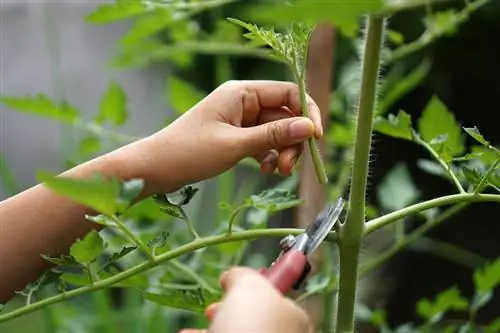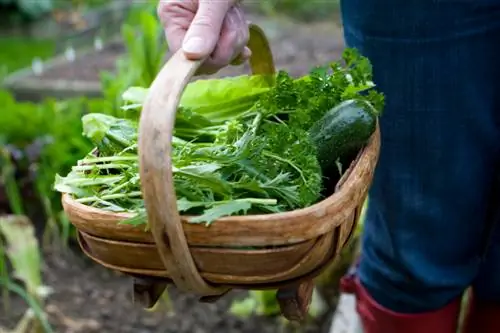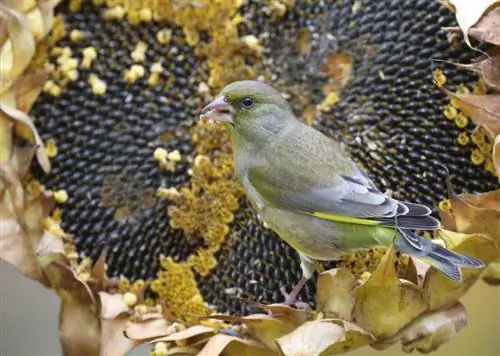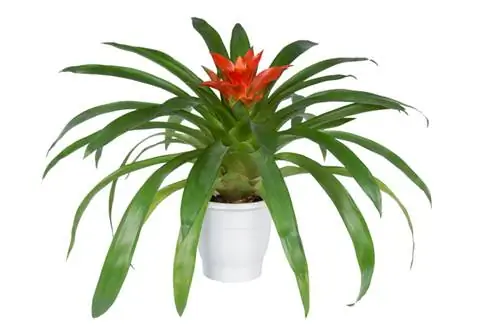- Author admin [email protected].
- Public 2023-12-26 14:17.
- Last modified 2025-06-01 06:02.
After your tomato plants have grown well in June, you should thin out the plants regularly. However, thinning is only an option if you have single-shoot tomatoes or cocktail tomatoes.
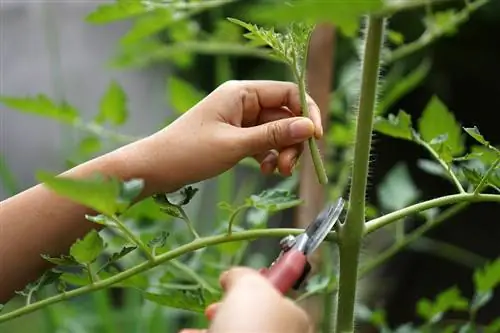
What does “pruning tomatoes” mean and how often should you do it?
With tomatoes, “pruning” means removing the shoots that grow in the leaf axils between the main stem and the fruit shoot. This gives the plant more energy for the fruits and better ventilation. Stick tomatoes in particular are harvested once or twice a week, while cocktail tomatoes and bush tomatoes are only partially or not at all.
What does “pruning” tomatoes mean?
Tomatoes form small shoots in the leaf axils between the main stem and side shoots. These can be removed regularly from June onwards to thin out the plant and direct the growth force into the fruits. The stingy shoots can be pinched off with your fingers. However, stripping also leads to wounds into which pathogens can penetrate. Therefore, only use as much as necessary.
When, from what size and how often are tomatoes pinched?
Prinding is an essential part of caring for tomato plants. Shoots that grow in the armpit between the main stem and the fruit-bearing side shoots are referred to by gardeners as stingy shoots In some tomato varieties, these stingy shoots drain a lot of energy from the plant, but in return they are “stingy” with fruit. Instead they form many leaves.
So that the energy flows into the flowers and into the ripening process, these stingy intermediate shoots are removed. But on the one hand this does not apply to every variety and on the other hand it does not apply to all growth phases. Some tomatoes are pinched once or twice a week, others only rarely and when necessary
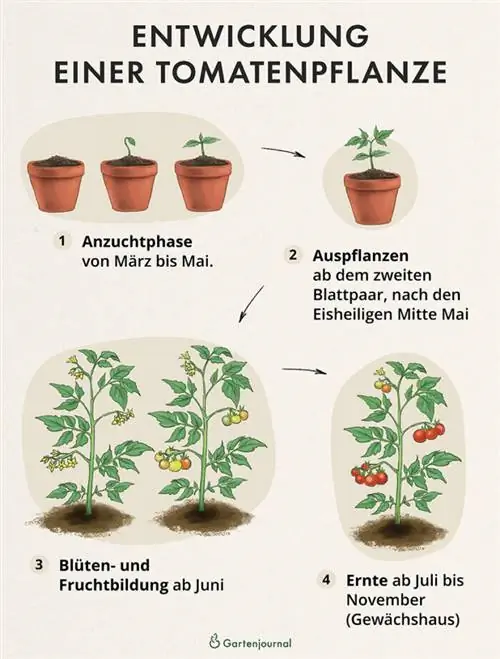
1) Cultivation phase:In the cultivation phase, which usually lasts fromend of February to mid-April, there is no need for thinning out Role. The small plants need all of their leaves in the first few weeks in order to grow vigorously.
2) Young plants:Pricked tomatoes already have the first real leaves, which are clearly different from the fine cotyledons on the outside. At this stage, the young plant is also left with all shoots until it has reached a height of approximately30 centimeters. Then it's time to move into the bed or greenhouse.
3) Mature tomato plants:When the tomato has gotten used to its new location, then the time for rooting out begins. Shoots that grow in the armpits are carefully removedfrom June. Depending on the variety, the procedure can be repeatedonce or twice a week. Tip: Carefully search each plant individually from top to bottom so that no miserliness goes undiscovered.
Instructions: How to thin tomatoes in 3 steps
The main shoot is the trunk from which fruit shoots with inflorescences come directly. The area between the trunk and the fruit shoot, i.e. the interface, is called the leaf axil. The unwanted miserliness sprouts from these acute angles.
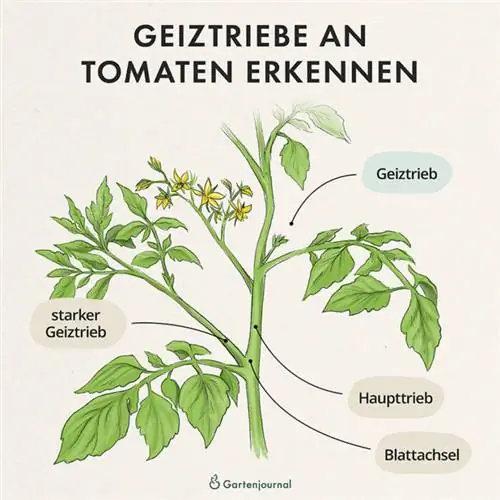
No tools are required for thinning, apart from secateurs for very thick shoots. It is enough to pinch off the shoots with your fingernail.
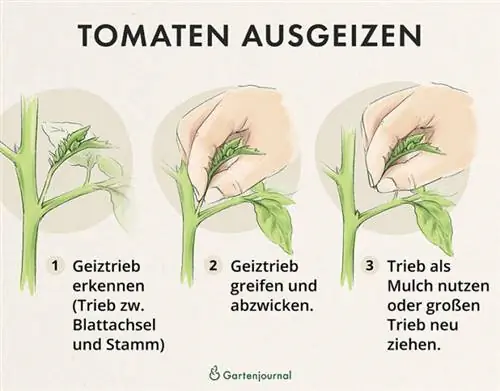
- Locate: Examine the plant systematically from top to bottom. Stingy shoots grow from the leaf axils between the trunk and the fruit shoot. The younger and smaller the miserliness is, the easier it is to remove.
- Grasping and escaping: In its early stages, the stingy instinct is grasped with the fingers just above the armpit. Ideally, a small tug to the side is enough to loosen the branch as if it were at a predetermined breaking point. Alternatively, you can also use your thumbnail for snapping. The wound remains small. However, if the shoot is older and woodier, breaking it can unnecessarily fray and enlarge the wound. Then it's better to use a sharp knife or secateurs (€16.00 on Amazon).
- Use: Small shoots can be used as mulch. Finger-thick shoots can be stimulated to form roots in a glass of water and later replanted as plants.
Author Melanie Grabner from lilatomate.de explains in the following video why austerity is so important to her and how she goes about it. She recommends watering the plant either the evening before or a few hours before rooting out. This means the tissue is tight and can be broken out more easily. You should also choose a dry day for work. Stingy shoots should be left standing if several leaves are infected with a fungal disease. In this case, every he althy shoot should be cared for.

Do you have to starve tomatoes?
No -Gardening opinions differ on this question Most experts and hobby gardeners agree that the tall growing stick tomato must be pruned. Even heavyweights such as the ox heart benefit significantly from targeted defoliation. This means the plant invests more energy in the fruits, which ripen better and taste sweeter. In addition, dried tomatoes dry much faster because more air blows through the plant parts. The removed shoots support growth as mulch or fertilizer.
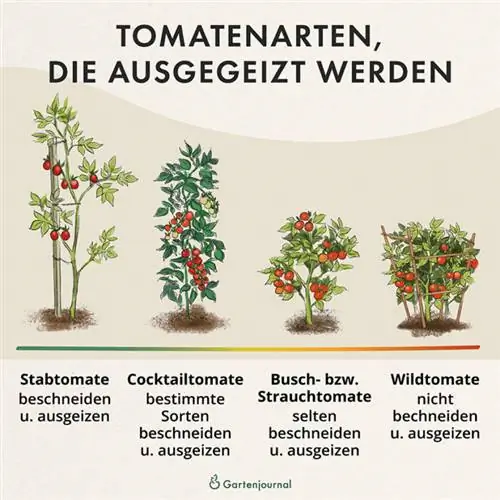
However, things are different with cocktail tomatoes, bush tomatoes and wild tomatoes. Because removing side shoots also has disadvantages. When stripping, awound spot is always created, which serves as an entry point for pathogens.
Tomatoes that are being pinched
Stick tomatoes
Stake tomatoes produce the largest share of the world's tomato crop. They areefficiently bredand take up very little space thanks to their upright and tall growth. However, this breeding has its price. Because the stick tomato developstoo many shoots Especially in our temperate climate zone, the warm season is simply too short, so not all of the fruits reach full ripeness. Therefore, in this country it is grown as a single stem or rarely with only one side shoot.
It may seem paradoxical, but the fewer flowers there are,the larger the actual harvest will be in the end. It is not uncommon for multi-shoot tomatoes to still be full of fruit in September. But unfortunately many remain green. It would be more efficient to check the plant twice a week for shoots and remove them. The shoot tip should also be cut in August as new flowers can no longer be supplied. This leaves enough energy for the still unripe fruits.
Cocktail tomatoes
The fruits of the cocktail tomato are quite small and light. There is no need to worry about thin side shoots collapsing under the load with these popular snacks. And the ripening process is much faster than with stick tomatoes, so that several flowers can be produced. A comparable undersupply is almost impossible for cocktail tomatoes, which are more closely related to their wild siblings.
Nevertheless, it may be worthwhile to go a little further. The cocktail tomato also cannot tolerate moisture on its leaves. To prevent fungal diseases, ventilation should be improved byremoving fewer shoots. Up to three fruit shoots can remain below. However, any shoots that form on the main shoot should be cut off. In addition, the smaller the planting distance between the tomatoes, the more thorough the cultivation must be.
Tomatoes that are not starved
Bush or vine tomatoes
Pruning bush or vine tomatoes is usually not doing them any favors. True to their name, they grow bushy and dense. With a height of almost one meter, they develop lots of fruits that can easily hang on the side shoots. Since they are naturally more resistant and robust, bush or vine tomatoesdo not need to be starved. However, if the shoots take up too much space,may be pruned now and then.
Wild Tomatoes
Wild tomatoes are not bred for high yields. Therefore, the plant knows very well how many shoots and fruits it can effectively supply with energy. It has been shown that wild tomatoesproduce the greatest yieldwithout pinching. Because every side shoot on it is also a fruit bud. The comfortable hobby gardener has the least work to do with the small wild tomatoes, which branch out a lot.
Special shapes
Refined Tomatoes
Refined tomatoes are the combination of two different varieties. For example, a vigorous and robust variety such as “Vigomax” is often used as a base on which a weak and sensitive variety is placed. The fruits that such a refined plant produces are those of the planted variety.
That's why when thinning out a grafted plant, you stick to therule that dictates the type of planted variety A stick tomato is processed accordingly, a planted bush tomato less. The base no longer plays a role. And you should give the tomato a little more time so that it can recover from the stress of grafting.
Young plants
After pricking out, the young plant should grow to30 centimeters. When it is then placed outdoors, in a container or in a greenhouse, the cotyledons are first removed. These are too close to the soil and are often hit by splashes when watering. The dreaded late blight and brown rot can find its way into the plant.
beef tomatoes
Beef tomatoes are among the largest fruits that a tomato plant can produce. Varieties such as ox heart can weigh up to one kilogram. For this reason alone,thorough thinning is necessary Because the thin side shoots break off due to the high load. In addition, many varieties are very susceptible to disease. Fewer leaves mean better ventilation and protection against fungal infections. That's why beefsteak tomatoes, like stick tomatoes, are grown in one stem.
Why do so many side shoots form on tomatoes?
It is primarily due toprofit-oriented breeding that some tomato varieties form so many side shoots. From an evolutionary perspective, the tomato initially only wants to preserve its species. It achieves this by producing seed-bearing fruits that are distributed around the environment by animals. But due to the crossing of different specimens, which produce particularly large and many fruits, a problem arises.
On the one hand, the fruits become too heavy, so shoots break off. On the other hand, there is not enough energy available to ripen the massive tomatoes. But the evolutionary pressure to keep growing in order to ensure reproduction does not let up. So more and more shoots and with them leaves, flowers and fruits are formed. But the formation of new shoots costs energy, which in turn is missing during the ripening process. The result: lots of green tomatoes and leaves.
Advantages and disadvantages of maxing out
Benefits of maximizing tomatoes
- More energy for existing fruit sets promises larger tomatoes
- Better ventilation thanks to less leaves
- More space allows for closer planting
- Faster drying of the sensitive leaves protects against diseases
- No bending of thin side shoots
- Removed shoots can be used as fertilizer, mulch or seedling
- Regular thinning enables early detection of diseases and nutrient deficiencies or mineral excesses
Disadvantages of maximizing tomatoes
- Open wounds on the main shoot: entry point for pathogens
- Additional effort (up to twice a week)
- Possibility of confusing a fruit shoot with a stingy shoot
- Less leaves may lead to sunburn on the fruits
The leaf mass created by thinning can be both protective and damaging to the tomato plant. For a successful tomato year, the preferences of the varieties grown should be taken into account. However, when it comes to making the most of it, it is also important to listen to your feelings. The right technique and the sensitivity for pruning develop over several years of gardening. All plants will forgive you small mistakes.
Video tip: maxing out vs. not maxing out

Hobby gardener Haiko from “one thousand and one garden tips” shows in his video experiment how thinning can affect the tomato harvest. In his outdoor bed with several tomato plants, he has exhausted all but one. And the big surprise: the unexploited plant survived an infection with late blight better than its neighbors.
Further use of miserliness
Grow new tomatoes from miserly shoots
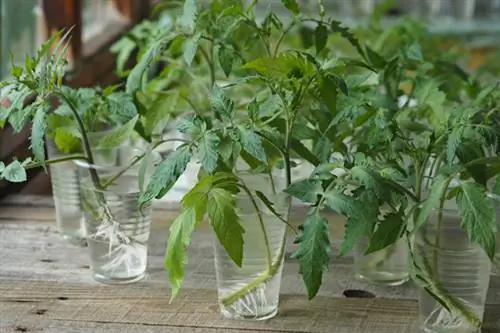
Instead of the compost, stingy shoots can also celebrate a second spring as a new tomato plant. To do this, a strong stem of ten centimeters is carefully separated from the trunk with a knife. The stem is then placed in a glass of water and positioned in a sunny spot. When visible roots form, the stem can go into the ground. Make sure the soil stays moist so the plant grows well. However, this process is only worthwhile until the beginning of June, otherwise the plants will no longer grow large enough to produce fruit.
Mixed culture - stingy shoots as a defense against insects in cabbage plants
Tomatoes are often grown in a mixed culture alongside cabbage plants by professional gardeners. Animal pests such as the cabbage fly stay away when the red fruits are involved. Alternatively, you can use a tomato cold water extract. To do this, crushed shoots and leaves are placed in water for two hours and then sprayed undiluted onto the cabbage plants.
More plants with stingy shoots
Physalis: In the case of the tasty Cape gooseberry, strong growth also leads to poor ventilation and too much shade. The shoots growing inwards can therefore be removed every few weeks. In contrast to tomatoes, thinning is more of an exception than a rule.
Cucumber: Pruning cucumbers helps on two levels. On the one hand, as with tomatoes, there is more energy and space left for the fruit. On the other hand, pruning the lower tips helps to keep the cucumbers from lying in the ground. But here too, austerity is the exception.
FAQ
What happens if I don't max out?
If tomatoes are not thinned out, the leaf mass can increase significantly. Tomatoes remain unripe and small. The dense growth inhibits drying and promotes diseases.
What happens when a miserliness breaks down?
If a miserliness breaks down, it's not a big deal. After all, pruning is about removing these shoots. Just remove the remaining shoot with your fingers. If it is a stingy shoot that has already grown thicker, take a pair of secateurs and pinch off the shoot at the leaf axil.
What happens when a miserliness gets too big?
You can also remove large stingy shoots. If the stinger is located in the lower part of the plant, do not remove it if the trunk is already woody. The risk of an open, non-healing wound would be too high.
How many shoots should be removed from a plant at once?
It doesn't matter how many shoots you remove from the tomato plant at the same time. Remove any sprouts that appear, especially in the first half of the season. In addition, you should regularly cut off old and diseased shoots and leaves using secateurs. This will keep the tomato plant vital and he althy.
How are tomatoes harvested?
The stingy shoots are located between the leaf axils. There they are broken out with the fingers when they are young. If they are older, a sharp knife or secateurs is recommended.
When should the last time be maxed out?
You should stop pinching out when the growth phase of the tomato plant is slowly coming to an end. From the second half of August onwards, you no longer have to make as much use as you did at the beginning.

